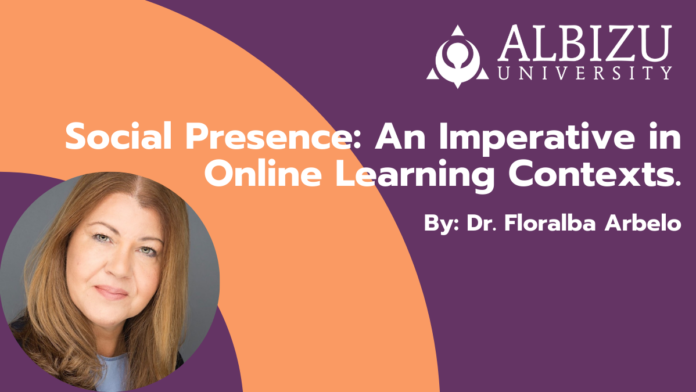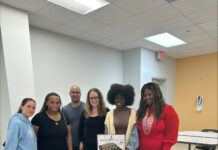Online learning can be challenging for Hispanic students, whose culture values dialogue, caring, and a shared celebration of their cultural heritage. Although this need for intense engagement may seem at odds with the concept of remote learning, it can be achieved through institutional attention to social presence—that is, the authentic exchanges, social cues, norms, and behaviors between students, faculty, and administrators that lead to a sense of belonging to an institution. During the COVID-19 pandemic, the importance of infusing social presence into remote teaching, learning, and student services is all the more acute. This paper discusses the role of culture in social presence and how teaching and learning, faculty disposition, and cultural competence can be used meaningfully to attain this.
Keywords: social presence, Hispanic college students, retention, online learning
Introduction
In 2020—the year of COVID-19 and attendant government health regulations and pandemic hotspots— higher education has had to step back and evaluate best practices for online teaching and learning that are contextual for specific cultural environments, such as that of Hispanic students. For institutions that were still emergent in their online degree and course offerings, it was and still is a steep learning curve to understand online teaching and how to remotely enhance the student sense of belonging to an institution—that is, their connections to faculty, programs, and administration. In online teaching and learning, this sense of connection is often linked to social presence: the authentic exchanges, social experiences, social cues, norms, and behaviors between students, faculty, and administrators (Plante & Asselin, 2014; Short et al., 1976). Social presence is associated with student satisfaction and connectedness to an institution (Richardson, et al. 2017). In turn, this sense of belonging can positively affect student agency in a remote learning environment (Joksimovic et al., 2015; Rockinson-Szapkiw, 2016).
Prior to the COVID-19 pandemic, although online learning had become established as an educational medium for many colleges and universities in the United States, large numbers of students preferred attending classes on campus or took hybrid courses, which combined hybrid or asynchronous online courses with attending classes and participating in activities on campus. Institutions that serve Hispanic student populations had to strategize how to successfully engage this group in virtual environments—that is, how to address cultural and ethnic constructs in an online teaching, learning, and support context. In 2020, experiencing courses, services, and student life remotely was still a novel experience for many Hispanic students. The move to a fully remote college experience as a result of the pandemic produced barriers to success for those students who had limited experience in virtual learning and were comfortable attending a physical campus, directly interacting with peers and faculty, and accessing on-campus services to support their academic goals. At some institutions, insensitivity to culture and ethnicity in the virtual learning context further hampered teaching, learning, and student support efforts.
Hispanics are the emerging minority majority in the United States, yet Hispanic college student completion rates are around 50%. This is an increase from the past decade, but it also indicates that for every Hispanic student enrolled in an undergraduate degree program, only one out of every two will complete the degree. Furthermore, only 24% of Hispanic adults in the United States have earned an associate degree or higher (Espinosa et al., 2019; Excelencia in Education, 2020). Institutions of higher education must do better by their Hispanic students. Lack of degree completion creates a tenuous path to gainful employment in a knowledge- and technology-driven economy, especially during times of economic uncertainty. Now more than ever, institutions should assess their online educational delivery practices to develop tailored and inclusive practices that engage and retain their Hispanic students in virtual learning environments.
Among Hispanic Serving Institutions (HSIs) in the United States—defined as those with a full-time student enrollment that is at least 25% Hispanic—Hispanic student enrollment has increased 281% since 1996, with the highest concentration of HSIs located in Florida, Texas, Illinois, New Mexico, New York, and California (Espinosa, et al., 2019). With this increased enrollment of Hispanic students comes an increased accountability to develop teaching and learning experiences that support Hispanic student degree completion. Among those practices is ensuring that in a remote college environment, an online social presence is active across courses, support services, and student life.
But how exactly do institutions develop an online social presence among Hispanic student populations to effectively support their academic and social development? What high-impact practices can institutions implement toward this effort?
Understanding Social Presence
Social presence, a term developed by Short, Williams, and Christie (1976), refers to the awareness of interactions and the development of interpersonal relationships in virtually mediated environments. The construct evolved over time through the work of diverse scholars. Gunawardena (1995) defined it as how an individual is perceived as a real person in virtual contexts, and Lowenthal (2010) further developed the construct of social presence as occurring on a continuum of experiences predicated on communication, relationships, and perceptions between parties in virtual contexts. In other words, in a virtual exchange between individuals, social presence relates to how present those individuals are; how salient the exchange is, based upon the interaction, any needs, and the difference that is made in a given interaction; and how the relationship evolves as a result of a series of interactions (Short et al., 1976). Human beings depend upon relational cues, such as head nodding, eye contact, facial expressions, voice intonation, and body language, to express how they understand and react to situations. In a virtual learning context, this is indicated by how present faculty and support staff are in the online learning context and whether they engage in behaviors that involve and support students, especially in asynchronous learning environments. Interpersonal relationships may be superficial or well developed on the social presence continuum. That is, they may be rated as becoming meaningful over time, as interpersonal relationships develop between individuals or among groups. Arguments still exist about the meaning and contexts of social presence, but for the purposes of this paper, social presence is defined as how students perceive and develop a sense of connection to faculty, peers, and staff in a virtual context through their interactions with and the support they receive from faculty and administrative staff.
Online social presence can be as simple as consistent communication between individuals or groups using applications such as text messages, emails, and announcement boards or as complex as supervised group work in learning management systems. Engagement strategies may also be implemented in online teaching and learning to increase social presence and student retention in online courses (Boston et al. 2010; Gunawardena & Zittle, 1997; Joksimovic et al., 2015; Rockinson-Szapkiw, 2016). Early studies on social presence identified the importance of emotional links and a sense of connectedness for students and established social presence as a main predictor of satisfaction in virtual learning contexts and in perceived learning (Gunawardena & Zittle, 1997; Swan & Shih, 2005). These studies highlighted how student satisfaction and perceived learning were supported by verbal exchanges that included humor, value, facial language, gestures, intonation and speed of verbal expressions, salutations, group references, approval, and advice. How faculty, staff, and administration present themselves in video chats or classes, how they dialogue with students, the manner of their speech, their intonations, their affective displays, and the quality of their exchanges with students all contribute to the student experience in the virtual environment and the sense of social presence.
Community of Inquiry and Culturally Responsive Pedagogy
In the context of the Community of Inquiry (COI) and Culturally Responsive Pedagogy (CRP) frameworks, the student educational experience is at the center of all methods of improving online social presence (Rourke & Kanuka, 2009). These frameworks suggest that setting the course climate, course content, and supporting discourse among students and faculty in the virtual context (Garrison et al., 2000; Garrison & Vaughan, 2007), while respecting diversity, enhances the educational experience of online students and increases social presence, which in turn supports learning (Ladson-Billings, 1992; Caudle, 2013). Course design and faculty, staff, and support interactions that value diverse cultures, create a climate of awareness of individual differences, and emphasize contributions to society by minority groups support inclusivity and bring diverse student agency to the online learning process. Lee (2014) further suggested that social presence is linked to cognitive presence, that is, how students construct knowledge through sustained discourse and reflection. Social presence is not solely responsible for the success of formal communications that take place in the online classroom, but it is considered a dominant construct in expanding learning. Course design, faculty-student exchanges, engagement and instructional strategies, course content presentation, types of assignments, the learning management system, communication types, and communication frequency all contribute to a student’s sense of connectedness to the educational institution (Akyol & Garrison, 2008). Their motivation in learning is further authenticated when ethnicity and culture are respected and included in the learning process. Both COI and CRP inform social presence through the inclusivity of culture in online teaching, learning, and support, enhancing the interactions of diverse students in the virtual learning environment and showing respect and appreciation for their cultures by acknowledging and celebrating differences (Ladson-Billings, 1992).
Toward Social Presence in the Virtual Learning Experiences of Hispanic Students
Teaching and Learning. To bring social presence to virtual teaching and learning, both faculty and students should interact in ways that engage critical inquiry and ensure inclusivity. In course design, this means much more than simply placing course content on a learning management system for students to access based on a checklist of criteria. In teaching, it means more than simply developing a set of readings, assignments, and assessments and expecting the student to instinctively understand the institutional norms of virtual learning. To effectively address the needs of Hispanic and other minority students in online learning, cultural and ethnic inclusivity must factor into the construction of remote college experiences. The interpersonal communication, cultural norms, and social behaviors developed for virtual environments should integrate practices that speak to the culture and ethnicity of the learning community (Altugan, 2015; Gingrich & Smith, 2014; Jayatilleke & Gunawardena, 2014).
Hispanic college students come from rich cultural environments that promote dialogue, caring, a respect for cultural cues, and shared responsibility for constructing and maintaining their cultural heritage and experiences (Houtman, Makos, & Meacock, 2014). These strong cultural influences, which impact Hispanic student learning, are translatable to virtual learning contexts, particularly in course design. By mirroring the cultural experience of mutual engagement in online learning, course designers, faculty, and administrators can increase social presence through meaningful interactions that result in a shared learning experience and knowledge construction, with students becoming agents in their own and their peers’ learning experiences (Hacker & Nedierhauser, 2000). This type of engagement and inclusivity promotes social presence both among students and within the learning community (Martino et al., 2009). When students are active participants in their own learning experiences, they are more present for their learning communities; when faculty engage in this type of teaching and learning experiences, they are more present for their students.
Developing and Sustaining Social Presence. As the dean of students at a Hispanic Serving Institution that is providing fully remote learning and support services to students during the COVID-19 pandemic, I have had numerous conversations with students over the past six months about their experiences with virtual teaching and learning. Hispanic students describe interactivity in both synchronous and asynchronous contexts that gives them a sense of social presence—that is, interactions that help them develop a sense of belonging to a group. In conversations and written reflections, some of the terms they used to describe interactivity that promoted awareness of others were “online live class meetings and discussions,” “using chat rooms,” “collaborate,” “Skype,” and “document sharing” through applications that allow several students to collaborate on projects, such as Google Docs and Microsoft Teams. Helpful activities included forming virtual study groups or cooperatives where each member brought their knowledge to share at the session and inviting students who were more advanced in their degree programs to speak about their own experiences with content, providing tips and useful information. Some of these interactions were structured within course and program design, others were organically formed by students, for students.
Other types of exchanges that led to awareness of others included the discussion board assignments in online courses, with students describing this learning tool as means of “getting to know their peers” and “how peers think,” “develop ideas,” and “learn about course content” by reading and engaging with their peers on course subject matter. The introductory discussion board, where students posted their biographies, photos, and interests, was mentioned by several students as a means to “determine what classmates to reach out to” in the course. Students were more apt to connect with those who had similar life situations such as work and families, were at the same stage of a degree program, or shared similar hobbies, experiences, and interests. This type of engagement served as a means of developing social presence for students in the online learning environment, as well as a means of sizing up their peers and determining who they might wish to collaborate with throughout the term. Students noted that these types of interactions helped them feel that others were “present” in their learning experiences.
One online learning activity that several students mentioned was class presentations, in which students presented course content, papers written, and projects completed using videoconferencing in a synchronous context. This not only generated a sense of social presence among participants but also served as a motivator to improve their own performance and self-efficacy using the available online teaching and learning tools. One student described this process as follows: “Watching and learning from my peers when they presented their projects helped me stay connected and motivated me to do better in the course.” Past research has shown that interactions alone do not define social presence among students, but relational presence, the ability to develop relationships and sustain ongoing meaningful interactivity, can index social presence (Kehrwald, 2008). Meaningful interaction—where a student is not only a participant but is actively attentive to others—similarly promotes social presence in a virtual context (Boston et al., 2010; Cui, et al., 2012). Creating opportunities for sustainable relationships to develop should be a strong consideration in course design and implementation.
Faculty Disposition and Engagement. Faculty disposition and engagement in the learning process is a strong factor in establishing social presence in virtual settings. At the surface, faculty behaviors that promote social presence—such as answering student questions in a timely manner, providing thorough and useful feedback on assignments, and being attentive to student needs—are invaluable in providing a model for student interactions (Plante & Asselin, 2014). Faculty members demonstrate social presence when they are resourceful, connect with support services to refer students in need, take the time to identify resources and information that students need to get “unstuck” in a particular process, share resources and ideas, and help students work through their own ideas. Anecdotally, students described as supportive and present for them faculty who offered virtual question and answer sessions and provided check-ins for students, even if the course was in asynchronous format. In synchronous courses, faculty were considered ‘present’ and ‘aware’ for students when they not only gave lectures but also encouraged discussion, encouraged asking questions, demonstrated patience, supported students in navigating a course, demonstrated that they did not mind responding to emails, and made it clear that students were valuable active members of a learning community.
As previously noted, Hispanic students come from strong communities of engagement. When this type of environment can be cultivated in a virtual context, it creates the type of social structure that provides an anchor for them in online learning (Arbelo-Marrero et al. 2019). Promoting peer interaction by pairing students into learning groups supports the development of funds of knowledge and information sharing, those rich and resourceful connections that students use to support one another. Leveraging teaching assistants to support social presence (while not replacing faculty) is another strategy that can be used to provide a sense of belonging in a virtual environment. Teaching assistants can be a strong support for students, serve as a bridge between faculty and students when needed, support faculty engagement, decrease the response time for queries, and identify student problems within and outside of courses before they become problems. Thinking of nontraditional ways to use teaching assistants in a virtual context has strong potential to support social presence.
Faculty Knowledge of Hispanic Student Realities. Faculty who work with Hispanic students may not be aware of certain realities in their lives that impede their forming a sense of social presence (Soper & Ukot, 2016). To effectively work with Hispanic students, faculty should have the ability to recognize diversity among students beyond a name, skin color, or English writing competence and know that the students have a variety of realities. For example, students may have extended family living in the same home, may be sharing technology devices with siblings or with children, may be currently responsible for their own children’s education, or may have a financial obligation to support their families. Any of these may influence a student’s ability to develop social presence or engage in online course activities (Plotts, 2018). Competing schedule obligations for time and technology, Zoom fatigue, crowded and shared spaces, and navigating cultural norms, such as whether it is appropriate to communicate with faculty via email during late night hours, are considerations when building social presence and meaning in virtual learning contexts (Sandoval-Lucero, Maes & Klingsmith, 2014; Sollitto, Johnson, & Meyers, 2013). For students with the added obligations of family and work, accessibility to faculty is instrumental in meeting their course obligations. Yes, timely submission of assignments is important, but just as important are personal factors that get in the way of students completing assignments.
Final Thoughts
If institutions that serve Hispanic students are serious about sustaining online programming in the post- COVID-19 era, attention to social presence will have to factor into the virtual college experience. This attention should go beyond ensuring the mastery of academic competencies in an online course or degree program to encouraging interpersonal relationships cultivated with faculty and peers, services linked to personal and professional development, and opportunities to engage with the learning community in meaningful ways. Institutional consideration for the cultural particularities of Hispanic students, including understanding and using their collective experiences to inform practices that increase social presence, will be imperative to the ability of those students to successfully navigate college in a virtual context. For institutions that continue remote learning, taking the time to listen to, understand, and attend to student needs will not only a factor into retention but may ultimately impact the future health of academic programs and perhaps the overall institution as well.
For the full article visit: https://bit.ly/36N9DKP






